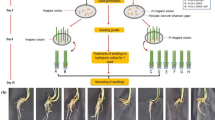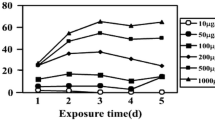Abstract
NO, as a signaling molecule, is involved in abiotic stresses. Limonium bicolor seedlings were treated with 200 mM NaCl combined with 0.05 mM SNP for 20 days to study the effects of NO on development and salt-secretion rates of salt glands. It was shown that the total number of salt glands on adaxial surfaces under condition of 200 mM NaCl containing 0.05 mM SNP treatment increased significantly compared with that under 200 mM NaCl treatment. Na+ secretion rate per leaf under 200 mM NaCl containing 0.05 mM SNP was significantly higher than that under 200 mM NaCl without SNP. However, there was no significant difference in salt-secretion rate of individual salt glands between 200 mM NaCl containing 0.05 mM SNP treatment and 200 mM NaCl treatment. Although there was no significant difference in salt-secretion rate of individual glands, Na+ concentration in the leaves treated with 200 mM NaCl solution containing SNP was significantly lower than that treated with 200 mM NaCl solution. Treatment with 200 mM NaCl solution containing SNP caused a remarkable increase in Na+ concentration in salt glands. Obviously, the efficiency of the secretion process per gland was enhanced by adding SNP to NaCl. The results showed NO may enhance the salt secretion by inducing more dermatogen cells to develop into salt glands and by enhancing the efficiency of the secretion process per gland.





Similar content being viewed by others
References
Atkinson MR, Findlay GP, Hope AB et al (1967) Salt regulation in the mangroves Rhizophora mucronata Lam. and Aegialitis annulata R. Aust J Biol Sci 20:589–599
Beligni MV, Lamattina L (2000) Nitric oxide stimulates seed germination and de-etiolation, and inhibits hypocotyl elongation, three light-inducible responses in plants. Planta 210:215–221
Bethke PC, Badger MR, Jones RL (2004) Apoplastic synthesis of nitric oxide by plant tissues. Plant Cell 16:332–341
Chen J, Xiao Q, Wu FH et al (2010) Nitric oxide enhances salt secretion and Na+ sequestration in a mangrove plant, Avicennia marina, through increasing the expression of H+-ATPase and Na+/H+ antiporter under high salinity. Tree Physiol 30:1570–1585
Delledonne M, Xia YJ, Dixon RA, Lamb C (1998) Nitric oxide functions as a signal in plant disease resistance. Nature 94:585–588
Durner J, Klessing DF (1999) Nitric oxide as a signal in plants. Curr Opin Plant Biol 2:369–374
García-Mata C, Lamattina L (2001) Nitric oxide induces stomatal closure and enhances the adaptive plant responses against drought stress. Plant Physiol 126:1196–1204
Giba Z, Grubišiæ D, Todoroviæ S, Sajc L, Stojakoviæ Ð, Konjeciæ R (1998) Effects of nitric oxide-releasing compounds on phytochrome-controlled germination of Empress tree seeds. Plant Growth Regul 26:175–181
Gouvêa CMCP, Souza JF, Magalhães CAN, Martins IS (1997) NO-releasing substances that induce growth elongation in maize root segments. Plant Growth Regul 21:183–187
Hilu KW, Randall JL (1984) Convenient method for studying grass leaf epidermis. Taxon 33:413–415
Kanai M, Higuchi K, Hagihara T, Konishi T, Ishii T, Fujita N, Nakamura Y, Maeda Y, Yoshiba M, Tadano T (2007) Common reed produces starch granules at the shoot base in response to salt stress. New Phytol 176:572–580
Lamotte O, Courtois C, Barnavon L, Pugin A, Wendehenne D (2005) Nitric oxide in plants: the biosynthesis and cell signaling properties of a fascinating molecule. Planta 221:1–4
Leshem YY, Haramaty E (1996) Plant aging: the emission of NO and ethylene and the effect of NO-releasing compounds on growth of pea (Pisum sativum) foliage. J Plant Physiol 148:258–263
Leshem YY, Wills RBH, Ku VV (1998) Evidence for the function of the free radical gas-nitric oxide (NO) as an endogenous maturation and senescence regulating factor in higher plants. Plant Physiol Biochem 36:825–833
Li WH (2008) Transformation of tobacco with MCT gene and the functional analysis of Ls NHXs genes from Limonium sinense. Shandong Normal University, Jinan
Ling TF, Xuan W, Fan YR, Sun YG, Xu SH, Huang BK, Huang SR, Shen WB (2005) The effects of exogenous glucose, fructose and NO donor sodium nitroprusside (SNP) on rice seed germination under salt stress. J Plant Physiol Mol Biol 31:205–212
Liphschitz N, Waisel Y (1974) Existence of salt glands in various genera of the Gramineae. New Phytol 73:507–513
Marcum KB, Murdoch CL (1992) Salt tolerance of the coastal salt marsh grass, Sporobolus virginicus (L.) Kunth. New Phytol 120:281–288
Meier SD, Kovalchuk Y, Rose CR (2006) Properties of the new fluorescent Na+ indicator CoroNa Green: comparison with SBFI and confocal Na+ imaging. J Neurosci Methods 155:251–259
Pedroso MC, Durzan DJ (2000) Effects of different gravity environments on DNA fragmentation and cell death in Kalanchoe leaves. Ann Bot 86:983–994
Pedroso MC, Magalhaes JR, Durzan DJ (2000a) Nitric oxide induces cell death in Taxus cells. Plant Sci 157:173–180
Pedroso MC, Magalhaes JR, Durzan DJ (2000b) A nitric oxide burst precedes apoptosis in angiosperm and gymnosperm and foliar tissues. J Exp Bot 51:1027–1036
Pollak G, Waisel Y (1970) Salt secretion in Aeluropus litoralis (Willd.) Parl. Ann Bot 34:879–888
Ramadan T, Flowers TJ (2004) Effects of salinity and benzyl adenine on development and function of microhairs of Zea mays L. Planta 219:639–648
Ribeiro EA, Cunha FQ, Tamashiro WMSC, Martins LS (1999) Growth phase dependent subcellular localization of nitric oxide synthase in maize cells. FEBS Lett 445:283–286
Rozema J, Riphagen I (1977) Physiology and ecologic relevance of salt secretion by salt glands of Glaux maritime L. Oecologia 29:349–357
Shimony C, Fahn A (1968) Light and electron microscopical studies on the structure of salt glands of Tamarix aphylla. J Linnean Soc 60:282–288
Thomson WW, Faraday CD, Oross JW (1988) Salt glands. In: Baker DA, Hall JL (eds) Solute transport in plant cells and tissues. Longman, Harlow, pp 498–537
Vassilyev AE, Stepanova AA (1990) The ultrastructure of ion-secreting and non-secreting salt gland of Limonium platyphyllum. J Exp Bot 41:41–46
Zhang YY, Wang LL, Liu YL, Zhang Q, Wei QP, Zhang WH (2006) Nitric oxide enhances salt tolerance in maize seedlings through increasing activities of proton-pump and Na+/H+ antiport in the tonoplast. Planta 224:545–555
Zhao L, Zhang F, Guo J, Yang Y, Li B, Zhang L (2004) Nitric oxide functions as a signal in salt resistance in the calluses from two ecotypes of reed. Plant Physiol 134:849–857
Zhou S, Zhao KF (2003) Discussion on the problem of salt gland of Glycine soja. Acta Bot Sin 45:574–580
Ziegler H, Lüttge U (1967) Die Salzdrusen Von Limonium Vulgare: Die Lokalisierung des Chloride. Planta 74:1–17
Author information
Authors and Affiliations
Corresponding author
Additional information
Communicated by S. Weidner.
Rights and permissions
About this article
Cite this article
Ding, F. Effects of salinity and nitric oxide donor sodium nitroprusside (SNP) on development and salt secretion of salt glands of Limonium bicolor . Acta Physiol Plant 35, 741–747 (2013). https://doi.org/10.1007/s11738-012-1114-8
Received:
Revised:
Accepted:
Published:
Issue Date:
DOI: https://doi.org/10.1007/s11738-012-1114-8




